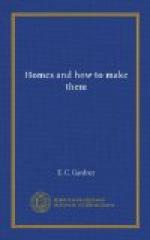In spite of Mrs. John’s devotion to her first love (I mean the stone walls), it is, as you say, quite possible that our family mansion will be wood; and Barkis is willin’ to hear what you have to say about it.
One topic in your reply to my wife’s historical report I hope you will work up more fully. Just explain, if you can, why the cheap buildings we have nowadays are so much less satisfactory to look at than those built fifty or a hundred years ago. Do you suppose the bravest artist that ever swung a brush would dare put an ordinary two-story house of modern style on the front seat in a New England landscape? It would ruin his reputation if he did,—even without the French roof. Can you tell why? There’s no such objection to the homesteads of a generation or two ago. Don’t tell me age is venerable, and moralize about the sacred associations and old-time memories that lend a halo of poetry and romance and what-’s-his-name to these relics of the past. That’s all very well in its place, but if our grandchildren can discover anything artistic or even picturesque in our common houses of to-day, they’ll be a progeny of enormous imaginations,—regular Don Quixotes; windmills will be nothing to them.
Yours,
John.
LETTER XIX.
From the Architect.
The use and the abuse of wood.
Dear John: One reason, among many, why the old-time houses are more grateful to the eye than those of similar cost but modern style, is that they were built of wood honestly and legitimately used, when wood was on all accounts the most suitable material for building. It is so still, and will be for a long time in many places, for its economy and convenience. Given a fair chance, it may be made very durable, and is even rendered practically fire-proof without great cost, by kyanizing and various other methods that are adopted for the same purpose. You will find one mode described in the June number of Harper’s Magazine for 1870. Wood is effective, too, in appearance, when rightly used, which, more’s the pity, does not often happen; for of all the materials that minister to human comfort and needs, this seems to me the most abused. Iron, like the old-time saints, betrays not its solid worth till it has been tried by fire,—is all the better for being hammered and beaten; stone is as much improved as an unruly boy by a good dressing; while bricks, like ghosts, come forth from their purgatory for the express purpose of being laid. All of these, by appropriate treatment, are invested with graces and glories that by nature they never owned. But a tree, graceful, noble, and grand beyond all human imitation, is ignominiously hewn down, every natural beauty disguised or annihilated, and its helpless form compelled to assume most uncouth shapes and grimmest colors.
[Illustration: The Groves were god’s first Temples.]




